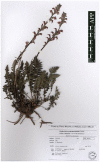Pedicularis rostratospicata subsp. marsica (P. Sect. Rostratae, Orobanchaceae), a New Subspecies from the Central Apennines (Italy)
- PMID: 37514231
- PMCID: PMC10384889
- DOI: 10.3390/plants12142614
Pedicularis rostratospicata subsp. marsica (P. Sect. Rostratae, Orobanchaceae), a New Subspecies from the Central Apennines (Italy)
Abstract
The new subspecies Pedicularis rostratospicata subsp. marsica is here described based on morphological and molecular analyses. The new taxon is endemic to few localities of the Central Apennines within the Abruzzo, Lazio and Molise National Park (Central Italy). Pedicularis rostratospicata subsp. marsica can be distinguished from the other two currently accepted subspecies (subsp. rostratospicata and subsp. helvetica) by their taller stems, shorter petioles of basal and middle leaves, narrower blades of basal leaves, longer inflorescences with longer internodes and more flowers, and longer calyx lobes. Molecular analysis confirmed the autonomy of the new taxon. Furthermore, the conservation status assessment of the new subspecies according to IUCN categories and criteria is proposed and discussed, and an analytical key to the three subspecies of P. rostratospicata is presented.
Keywords: Abruzzo; National Park; endemism; molecular phylogeny; nomenclature; taxonomy.
Conflict of interest statement
The authors declare no conflict of interest.
Figures









References
-
- Fischer E. Scrophulariaceae. In: Kadereit J.W., editor. Flowering Plants·Dicotyledons: Lamiales (except Acanthaceae including Avicenniaceae) Springer; Berlin/Heidelberg, Germany: 2004. pp. 333–432.
-
- Yu W.-B., Liu M.-L., Wang H., Mill R.R., Ree R.H., Yang J.-B., Li D.-Z. Towards a comprehensive phylogeny of the large temperate genus Pedicularis (Orobanchaceae), with an emphasis on species from the Himalaya-Hengduan Mountains. BMC Plant Biol. 2015;15:176. doi: 10.1186/s12870-015-0547-9. - DOI - PMC - PubMed
-
- Peruzzi L., Conti F., Bartolucci F. An inventory of vascular plants endemic to Italy. Phytotaxa. 2014;168:1–75. doi: 10.11646/phytotaxa.168.1.1. - DOI
-
- Bartolucci F., Peruzzi L., Galasso G., Albano A., Alessandrini A., Ardenghi N.M.G., Astuti G., Bacchetta G., Ballelli S., Banfi E., et al. An updated checklist of the vascular flora native to Italy. Plant Biosyst. 2018;152:179–303. doi: 10.1080/11263504.2017.1419996. - DOI
-
- PFI Portale Della Flora d’Italia/Portal to the Flora of Italy, Version 2022.2. [(accessed on 10 June 2023)]. Available online: https://dryades.units.it/floritaly/
Grants and funding
LinkOut - more resources
Full Text Sources

